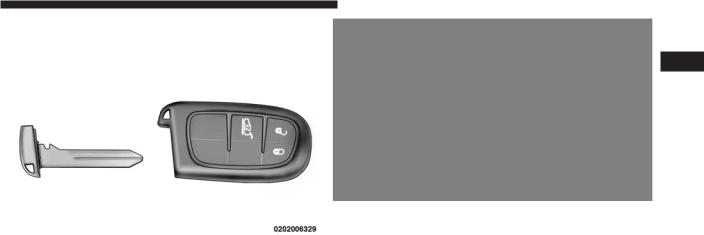Jeep Cherokee 2015 Owner's Manual

2 0 1 5 Cherokee
OW N E R ’ S M A N UA L

VEHICLES SOLD IN CANADA
With respect to any Vehicles Sold in Canada, the name FCA US LLC shall be deemed to be deleted and the name FCA Canada Inc. used in substitution therefore.
DRIVING AND ALCOHOL
Drunken driving is one of the most frequent causes of accidents.
Your driving ability can be seriously impaired with blood alcohol levels far below the legal minimum. If you are drinking, don’t drive. Ride with a designated nondrinking driver, call a cab, a friend, or use public transportation.
This manual illustrates and describes the operation of features and equipment that are either standard or optional on this vehicle. This manual may also include a description of features and equipment that are no longer available or were not ordered on this vehicle. Please disregard any features and equipment described in this manual that are not on this vehicle.
FCA US LLC reserves the right to make changes in design and specifications, and/or make additions to or improvements to its products without imposing any obligation upon itself to install them on products previously manufactured.
WARNING!
Driving after drinking can lead to an accident. Your perceptions are less sharp, your reflexes are slower, and your judgment is impaired when you
have been drinking. Never drink and then drive. 7
Copyright © 201 FCA US LLC

SECTION |
TABLE OF CONTENTS |
PAGE |
|
1 |
INTRODUCTION . . . . . . . |
. . . . . . . . . . . . . . . . . . . . . . . . . . . . . . . . . . . . . . . . . . . . . . . . . . . . |
. . . . 3 |
2 |
THINGS TO KNOW BEFORE STARTING YOUR VEHICLE . . . . . . . . . . . . . . . . . . . . . . . . . . . . . . |
. . . . 9 |
|
3 |
UNDERSTANDING THE FEATURES OF YOUR VEHICLE . . . . . . . . . . . . . . . . . . . . . . . . . . . . . . |
. . . 117 |
|
4 |
UNDERSTANDING YOUR INSTRUMENT PANEL . . . . . . . . . . . . . . . . . . . . . . . . . . . . . . . . . . . . |
. . 315 |
|
5 |
STARTING AND OPERATING . . . . . . . . . . . . . . . . . . . . . . . . . . . . . . . . . . . . . . . . . . . . . . . . . . |
. . 449 |
|
6 |
WHAT TO DO IN EMERGENCIES . . . . . . . . . . . . . . . . . . . . . . . . . . . . . . . . . . . . . . . . . . . . . . . . |
. . 603 |
|
7 |
MAINTAINING YOUR VEHICLE . . . . . . . . . . . . . . . . . . . . . . . . . . . . . . . . . . . . . . . . . . . . . . . . . |
. . 645 |
|
8 |
MAINTENANCE SCHEDULES . . . . . . . . . . . . . . . . . . . . . . . . . . . . . . . . . . . . . . . . . . . . . . . . . . |
. . 723 |
|
9 |
IF YOU NEED CONSUMER ASSISTANCE . . . . . . . . . . . . . . . . . . . . . . . . . . . . . . . . . . . . . . . . . . |
. . 729 |
|
10 |
INDEX . . . . . . . . . . . . . . |
. . . . . . . . . . . . . . . . . . . . . . . . . . . . . . . . . . . . . . . . . . . . . . . . . . . . . |
. . 739 |
1
2
3
4
5
6
7
8
9
10

INTRODUCTION |
1 |
CONTENTS
INTRODUCTION . . . . . . . . . . . . . . . . . . . . . . . .4
ROLLOVER WARNING . . . . . . . . . . . . . . . . . . .4
HOW TO USE THIS MANUAL . . . . . . . . . . . . . .5
WARNINGS AND CAUTIONS . . . . . . . . . . . . . .7
VEHICLE IDENTIFICATION NUMBER . . . . . . . .7
VEHICLE MODIFICATIONS/ALTERATIONS . . . .8

4 INTRODUCTION
INTRODUCTION
Congratulations on selecting your new FCA US LLC vehicle. Be assured that it represents precision workmanship, distinctive styling, and high quality - all essentials that are traditional to our vehicles.
This Owner’s Manual has been prepared with the assistance of service and engineering specialists to acquaint you with the operation and maintenance of your vehicle. It is supplemented by Warranty Information, and various customer-oriented documents. Please take the time to read these publications carefully. Following the instructions and recommendations in this manual will help assure safe and enjoyable operation of your vehicle.
NOTE: After reviewing the owner information, it should be stored in the vehicle for convenient referencing and remain with the vehicle when sold.
When it comes to service, remember that your authorized dealer knows your Jeep® vehicle best, has factory-trained technicians and genuine MOPAR® parts, and cares about your satisfaction.
JEEP is a registered trademark of FCA US LLC.
ROLLOVER WARNING
Utility vehicles have a significantly higher rollover rate than other types of vehicles. This vehicle has a higher ground clearance and a higher center of gravity than many passenger cars. It is capable of performing better in a wide variety of off-road applications. Driven in an unsafe manner, all vehicles can go out of control. Because of the higher center of gravity, if this vehicle is out of control it may roll over while some other vehicles may not.

Do not attempt sharp turns, abrupt maneuvers, or other unsafe driving actions that can cause loss of vehicle control. Failure to operate this vehicle safely may result in a collision, rollover of the vehicle, and severe or fatal injury. Drive carefully.
Rollover Warning Label
INTRODUCTION 5
Failure to use the driver and passenger seat belts provided is a major cause of severe or fatal injury. In fact, the 1 U.S. government notes that the universal use of existing seat belts could cut the highway death toll by 10,000 or more each year and could reduce disabling injuries by two million annually. In a rollover crash, an unbelted person is significantly more likely to die than a person wearing a seat belt. Always buckle up.
HOW TO USE THIS MANUAL
Consult the Table of Contents to determine which section contains the information you desire.
Since the specification of your vehicle depends on the items of equipment ordered, certain descriptions and illustrations may differ from your vehicle’s equipment.
The detailed index at the back of this Owner’s Manual contains a complete listing of all subjects.

6 INTRODUCTION
Consult the following table for a description of the symbols that may be used on your vehicle or throughout this Owner’s Manual:

WARNINGS AND CAUTIONS
This Owners Manual contains WARNINGS against operating procedures that could result in a collision or bodily injury. It also contains CAUTIONS against procedures that could result in damage to your vehicle. If you do not read this entire Owner’s Manual, you may miss important information. Observe all Warnings and Cautions.
VEHICLE IDENTIFICATION NUMBER
The Vehicle Identification Number (VIN) is found on the left front corner of the instrument panel. The VIN is visible from outside of the vehicle through the windshield. The VIN number also is stamped into the right front body, on the right front seat cross member. With the seat in the rear most position a flap in the carpet can be cut open and lifted to reveal the VIN. It also appears on
INTRODUCTION 7
the Automobile Information Disclosure Label affixed to a window on your vehicle, the vehicle registration, and the 1 title.
The VIN is also stamped on either right or left hand side of the engine block.
Vehicle Identification Number

8 INTRODUCTION
Right Front Body VIN Location
NOTE: It is illegal to remove or alter the VIN.
VEHICLE MODIFICATIONS/ALTERATIONS
WARNING!
Any modifications or alterations to this vehicle could seriously affect its roadworthiness and safety and may lead to a collision resulting in serious injury or death.

THINGS TO KNOW BEFORE STARTING YOUR VEHICLE
2
CONTENTS
A WORD ABOUT YOUR KEYS . . . . . . . . . . . . |
.12 |
▫ Ignition Node Module (IGNM) — If Equipped. |
.12 |
▫ Keyless Ignition Node (KIN) . . . . . . . . . . . . . . |
13 |
▫ Key Fob — If Equipped . . . . . . . . . . . . . . . . . . |
14 |
▫ Ignition Or Accessory On Message . . . . . . . . . . |
15 |
SENTRY KEY® . . . . . . . . . . . . . . . . . . . . . . . . . |
16 |
▫ Replacement Keys . . . . . . . . . . . . . . . . . . . . . |
18 |
▫ Customer Key Programming . . . . . . . . . . . . . . |
18 |
▫ General Information . . . . . . . . . . . . . . . . . . . . |
18 |
VEHICLE SECURITY ALARM — IF EQUIPPED . . . |
19 |
▫ Rearming Of The System . . . . . . . . . . . . . . . . |
.19 |
▫ To Arm The System . . . . . . . . . . . . . . . . . . . . |
19 |
▫ To Disarm The System . . . . . . . . . . . . . . . . . . . |
20 |
▫ Security System Manual Override . . . . . . . . . . . |
22 |
ILLUMINATED ENTRY . . . . . . . . . . . . . . . . . . . |
22 |
REMOTE KEYLESS ENTRY (RKE) . . . . . . . . . . . |
23 |
▫ To Unlock The Doors And Liftgate . . . . . . . . . . |
23 |
▫ To Lock The Doors And Liftgate . . . . . . . . . . . . |
24 |
▫ Using The Panic Alarm . . . . . . . . . . . . . . . . . . |
25 |
▫ Programming Additional Transmitters . . . . . . . |
25 |

10 THINGS TO KNOW BEFORE STARTING YOUR VEHICLE
▫ Transmitter Battery Replacement . . . . . . . . . |
. .25 |
▫ General Information . . . . . . . . . . . . . . . . . . . |
.29 |
REMOTE STARTING SYSTEM — IF EQUIPPED |
. .29 |
▫ How To Use Remote Start . . . . . . . . . . . . . . . .30
▫Remote Start Abort Message On Electronic Vehicle Information Center (EVIC) or Driver Information
Display (DID) — If Equipped . . . . . . . . . . . . . .31
▫ To Enter Remote Start Mode. . . . . . . . . . . . . . .31
▫ To Exit Remote Start Mode Without Driving
The Vehicle . . . . . . . . . . . . . . . . . . . . . . . . . .32
▫ To Exit Remote Start Mode And Drive The |
|
Vehicle . . . . . . . . . . . . . . . . . . . . . . . . . . . . |
. .32 |
▫ Remote Start Comfort Systems — If Equipped |
. .33 |
▫ Remote Start Windshield Wiper De–Icer |
|
Activation — If Equipped . . . . . . . . . . . . . . |
. .33 |
DOOR LOCKS . . . . . . . . . . . . . . . . . . . . . . . . |
.34 |
▫ Manual Door Locks . . . . . . . . . . . . . . . . . . . . . |
34 |
▫ Power Door Locks . . . . . . . . . . . . . . . . . . . . . |
35 |
▫ Child-Protection Door Lock System — |
|
Rear Doors . . . . . . . . . . . . . . . . . . . . . . . . . . |
37 |
KEYLESS ENTER-N-GO™ . . . . . . . . . . . . . . . . . |
38 |
WINDOWS . . . . . . . . . . . . . . . . . . . . . . . . . . . |
44 |
▫ Power Windows . . . . . . . . . . . . . . . . . . . . . . . |
44 |
▫ Wind Buffeting . . . . . . . . . . . . . . . . . . . . . . . |
46 |
LIFTGATE . . . . . . . . . . . . . . . . . . . . . . . . . . . . |
46 |
▫ Power Liftgate — If Equipped . . . . . . . . . . . . . |
48 |
OCCUPANT RESTRAINT SYSTEMS . . . . . . . . . . |
50 |
▫ Important Safety Precautions . . . . . . . . . . . . . . |
51 |

▫ Seat Belt Systems . . . . . . . . . . . . . . . . . . |
. . . .52 |
▫ Supplemental Restraint System (SRS) . . . . |
. . . .63 |
▫ Child Restraints . . . . . . . . . . . . . . . . . . . . |
. . .89 |
▫ Transporting Pets . . . . . . . . . . . . . . . . . . . |
. .111 |
ENGINE BREAK-IN RECOMMENDATIONS |
. . .111 |
SAFETY TIPS . . . . . . . . . . . . . . . . . . . . . . . |
. .112 |
THINGS TO KNOW BEFORE STARTING YOUR VEHICLE |
11 |
▫ Transporting Passengers . . . . . . . . . . . . . . . . |
.112 |
▫ Exhaust Gas . . . . . . . . . . . . . . . . . . . . . . . . . |
113 |
|
2 |
▫ Safety Checks You Should Make Inside |
|
The Vehicle . . . . . . . . . . . . . . . . . . . . . . . . . |
114 |
▫ Periodic Safety Checks You Should Make |
|
Outside The Vehicle . . . . . . . . . . . . . . . . . . . |
116 |

12 THINGS TO KNOW BEFORE STARTING YOUR VEHICLE |
|
|
|
|
|
|
|
A WORD ABOUT YOUR KEYS |
|
|
|
Your vehicle uses either a key start ignition system or |
|
|
|
keyless ignition system. The key start ignition system |
|
|
|
consists of a either a Key Fob with Remote Keyless Entry |
|
|
|
(RKE) transmitter and an Ignition Node Module (IGNM). |
|
|
|
The keyless ignition system consists of a Key Fob with |
|
|
|
Remote Keyless Entry (RKE) transmitter and a Keyless |
|
|
|
Ignition Node (KIN). |
|
|
|
Ignition Node Module (IGNM) — If Equipped |
|
|
|
The Ignition Node Module (IGNM) operates similar to an |
|
|
|
ignition switch. It has four operating positions, three with |
|
Ignition Node Module (IGNM) |
|
detents and one that is spring-loaded. The detent posi- |
|
||
|
|
||
tions are OFF, ACC, and ON/RUN. The START position |
1 |
— OFF |
|
is a spring-loaded momentary contact position. When |
2 |
— ACC (ACCESSORY) |
|
released from the START position, the switch automati- |
3 |
— ON/RUN |
|
|
|
4 |
— START |
cally returns to the ON/RUN position.

|
|
THINGS TO KNOW BEFORE STARTING YOUR VEHICLE 13 |
|
Keyless Ignition Node (KIN) |
|
||
|
|
|
|
This feature allows the driver to operate the ignition with |
2 |
||
the push of a button as long as the Remote Keyless Entry |
|||
(RKE) transmitter is in the passenger compartment. |
|
|
|
The Keyless Ignition Node (KIN System) has four oper- |
|
|
|
ating positions, three of which are labeled and will |
|
|
|
illuminate when in position. The three positions are: OFF, |
|
|
|
ACC, and ON/RUN. The fourth position is START. |
|
|
|
During start, ON/RUN will illuminate. |
|
|
|
NOTE: In case the ignition does not change with the |
|
|
|
push of a button, the RKE transmitter (Key Fob) may |
|
Keyless Ignition Node (KIN System) |
|
have a low or dead battery. In this situation, a back up |
|
||
|
|
|
|
method can be used to operate the ignition switch. Put |
1 — OFF |
||
the nose side (side opposite of the emergency key) of the |
2 — ACC (ACCESSORY) |
||
Key Fob against the Engine START/STOP button and |
3 — ON/RUN |
||
|
|
|
|
push to operate the ignition. |
|
|
|

14 THINGS TO KNOW BEFORE STARTING YOUR VEHICLE
Key Fob — If Equipped
The Key Fob also contains the Remote Keyless Entry (RKE) transmitter and an emergency key, which stores in the rear of the Key Fob.
The emergency key allows for entry into the vehicle should the battery in the vehicle or the Key Fob go dead. You can keep the emergency key with you when valet parking.
To remove the emergency key, slide the mechanical latch on the face of the Key Fob sideways with your thumb and
then pull the key out with your other hand.
Emergency Key Removal (IGNM System)

Emergency Key Removal (KIN System)
NOTE: You can insert the double-sided emergency key into the lock cylinders with either side up.
THINGS TO KNOW BEFORE STARTING YOUR VEHICLE 15
Ignition Or Accessory On Message
When opening the driver’s door when the ignition is in ACC or ON/RUN (engine not running), a chime will 2 sound to remind you to place the ignition in the OFF position. In addition to the chime, the ignition or accessory on message will display in the cluster.
NOTE: The power window switches, radio, power sunroof (if equipped), and power outlets will remain active for up to 10 minutes after the ignition is cycled to the OFF position. Opening either front door will cancel this feature. The time for this feature is programmable. Refer to “Uconnect® Settings” in “Understanding Your Instrument Panel” for further information.

16 THINGS TO KNOW BEFORE STARTING YOUR VEHICLE
WARNING!
•When leaving the vehicle, always remove the Key Fob from the vehicle and lock your vehicle.
•Never leave children alone in a vehicle, or with access to an unlocked vehicle.
•Allowing children to be in a vehicle unattended is dangerous for a number of reasons. A child or others could be seriously or fatally injured. Children should be warned not to touch the parking brake, brake pedal or the gear selector.
•Do not leave the Key Fob in or near the vehicle, or in a location accessible to children, and do not leave the ignition of a vehicle equipped with Keyless Enter-N-Go™ in the ACC or ON/RUN mode. A child could operate power windows, other controls, or move the vehicle.
WARNING! (Continued)
•Do not leave children or animals inside parked vehicles in hot weather. Interior heat build-up may cause serious injury or death.
CAUTION!
An unlocked car is an invitation to thieves. Always remove key from the ignition and lock all doors when leaving the vehicle unattended.
SENTRY KEY®
The Sentry Key® Immobilizer system prevents unauthorized vehicle operation by disabling the engine. The system does not need to be armed or activated. Operation is automatic, regardless of whether the vehicle is locked or unlocked.
(Continued)

The system uses a Key Fob with a factory-mated Remote Keyless Entry (RKE) transmitter, a Keyless Ignition Node (KIN) and a RF receiver to prevent unauthorized vehicle operation. Therefore, only Key Fobs that are programmed to the vehicle can be used to start and operate the vehicle. The system will not allow the engine to crank with an invalid Key Fob.
After placing the ignition to the ON/RUN position, the Vehicle Security Light will turn on for three seconds for a bulb check. If the light remains on after the bulb check, it indicates that there is a problem with the system. In addition, if the light begins to flash after the bulb check, it indicates that someone used an invalid Key Fob to start the engine. Either of these conditions will result in the engine being shut off after two seconds.
If the Vehicle Security Light turns on during normal vehicle operation (vehicle running for longer than 10 seconds), it indicates that there is a fault in the system. Should this
THINGS TO KNOW BEFORE STARTING YOUR VEHICLE 17
occur, have the vehicle serviced as soon as possible by an authorized dealer.
2
CAUTION!
•Do not make modifications or alterations to the immobilizer system. Modifications or alterations to the immobilization system may result in a loss of security protection.
•The Sentry Key® Immobilizer system is not compatible with some aftermarket remote starting systems. Use of these systems may result in vehicle starting problems and loss of security protection.
All of the Key Fobs provided with your new vehicle have been programmed to the vehicle electronics.

18 THINGS TO KNOW BEFORE STARTING YOUR VEHICLE
Replacement Keys
NOTE: Only Key Fobs that are programmed to the vehicle electronics can be used to start and operate the vehicle. Once a Key Fob is programmed to a vehicle, it cannot be programmed to any other vehicle.
CAUTION!
•Always remove the Key Fobs from the vehicle and lock all doors when leaving the vehicle unattended.
•For vehicles equipped with Keyless Enter-N-Go™, always remember to place the ignition in the OFF position.
NOTE: Duplication of Key Fobs may be performed at an authorized dealer. This procedure consists of programming a blank Key Fob to the vehicle electronics. A blank Key Fob is one that has never been programmed.
When having the Sentry Key® Immobilizer System serviced, bring all vehicle keys with you to an authorized dealer.
Customer Key Programming
Programming Key Fobs or RKE transmitters may be performed at an authorized dealer.
General Information
The Sentry Key® system complies with FCC rules part 15 and with RSS-210 of Industry Canada. Operation is subject to the following conditions:
•This device may not cause harmful interference.
•This device must accept any interference that may be received, including interference that may cause undesired operation.

NOTE: Changes or modifications not expressly approved by the party responsible for compliance could void the user’s authority to operate the equipment.
VEHICLE SECURITY ALARM — IF EQUIPPED
The Vehicle Security Alarm monitors the vehicle doors for unauthorized entry and the Keyless Enter-N-Go™ Start/Stop button for unauthorized operation. While the Vehicle Security Alarm is armed, interior switches for door locks and liftgate release are disabled.
If something triggers the alarm, the Vehicle Security Alarm will provide the following audible and visible signals:
•The horn will pulse.
•The park lamps and/or turn signals will flash.
•The Vehicle Security Light in the instrument cluster will flash.
THINGS TO KNOW BEFORE STARTING YOUR VEHICLE 19
Rearming Of The System
If something triggers the alarm, and no action is taken to disarm it, the Vehicle Security Alarm will turn the horn 2 off after 29 seconds, 5 seconds between cycles, up to 8 cycles if the trigger remains active and then the Vehicle Security Alarm will rearm itself.
To Arm The System
Follow these steps to arm the Vehicle Security Alarm:
1.Make sure the vehicles ignition is cycled to the “OFF” position (refer to Starting Procedures in Starting And Operating for further information).
•For vehicles equipped with Keyless Enter-N-Go™, make sure the vehicle ignition system is OFF.
•For vehicles not equipped with Keyless Enter-N- Go™, make sure the vehicle ignition system is OFF, and the key is physically removed from the ignition.

20 THINGS TO KNOW BEFORE STARTING YOUR VEHICLE
2.Perform one of the following methods to lock the vehicle:
•Push LOCK on the interior power door lock switch with the driver and/or passenger door open.
•Push the LOCK button on the exterior Passive Entry Door Handle with a valid Key Fob available in the same exterior zone (refer to Keyless Enter-N-Go™ in Things To Know Before Starting Your Vehicle for further information).
•Push the LOCK button on the Remote Keyless Entry (RKE) transmitter.
3.If any doors are open, close them.
To Disarm The System
The Vehicle Security Alarm can be disarmed using any of the following methods:
•Push the UNLOCK button on the Remote Keyless Entry (RKE) transmitter.
•Grasp the Passive Entry Unlock Door Handle with a valid Key Fob available in the same exterior zone (if equipped). Refer to Keyless Enter-N-Go™ in Things To Know Before Starting Your Vehicle for further information.
•Cycle the vehicle ignition system out of the OFF position.
•For vehicles equipped with Keyless Enter-N-Go™ , push the Keyless Enter-N-Go™ Start/Stop button (requires at least one valid Key Fob in the vehicle).

•For vehicles not equipped with Keyless Enter-N- Go™, insert a valid key into the ignition switch and turn the key to the ON position.
NOTE:
•The driver’s door key cylinder and the liftgate button on the RKE transmitter cannot arm or disarm the Vehicle Security Alarm.
•The Vehicle Security Alarm remains armed during power liftgate entry. Pushing the liftgate button will not disarm the Vehicle Security Alarm. If someone enters the vehicle through the liftgate and opens any door, the alarm will sound.
•When the Vehicle Security Alarm is armed, the interior power door lock switches will not unlock the doors.
THINGS TO KNOW BEFORE STARTING YOUR VEHICLE 21
The Vehicle Security Alarm is designed to protect your vehicle. However, you can create conditions where the system will give you a false alarm. If one of the previ- 2 ously described arming sequences has occurred, the Vehicle Security Alarm will arm regardless of whether you are in the vehicle or not. If you remain in the vehicle and open a door, the alarm will sound. If this occurs, disarm the Vehicle Security Alarm.
If the Vehicle Security Alarm is armed and the battery becomes disconnected, the Vehicle Security Alarm will remain armed when the battery is reconnected; the exterior lights will flash and the horn will sound. If this occurs, disarm the Vehicle Security Alarm.

22 THINGS TO KNOW BEFORE STARTING YOUR VEHICLE
Security System Manual Override
The Vehicle Security Alarm will not arm if you lock the doors using the manual door lock plunger.
ILLUMINATED ENTRY
The courtesy lights will turn on when you use the Remote Keyless Entry (RKE) transmitter to unlock the doors or open any door.
This feature also turns on the approach lighting in the outside mirrors — if equipped. Refer to “Mirrors” in “Understanding The Features Of Your Vehicle” for further information.
The lights will fade to off after approximately 30 seconds, or they will immediately fade to off once the ignition switch is turned to ON/RUN from the OFF position.
NOTE:
•The front courtesy overhead console and door courtesy lights do not turn on if the dimmer control is in the “Dome defeat” position (extreme bottom position).
•The Illuminated Entry system will not operate if the dimmer control is in the “Dome defeat” position (extreme bottom position).

REMOTE KEYLESS ENTRY (RKE)
Emergency Key Removal (KIN)
THINGS TO KNOW BEFORE STARTING YOUR VEHICLE 23
2
Emergency Key Removal (IGNM)
To Unlock The Doors And Liftgate
Push and release the UNLOCK button on the RKE transmitter once to unlock the driver’s door or twice within five seconds to unlock all doors and liftgate. The turn signal lights will flash to acknowledge the unlock signal. The illuminated entry system will also turn on.

24 THINGS TO KNOW BEFORE STARTING YOUR VEHICLE
If the vehicle is equipped with Passive Entry, refer to “Keyless Enter-N-Go™” in “Things To Know Before Starting Your Vehicle” for further information.
1st Push Of Key Fob Unlocks
This feature lets you program the system to unlock either the driver’s door or all doors on the first push of the UNLOCK button on the RKE transmitter. To change the current setting, refer to “Uconnect® Settings” in “Understanding Your Instrument Panel” for further information.
Flash Lamps With Lock
This feature will cause the turn signal lights to flash when the doors are locked or unlocked with the RKE transmitter. This feature can be turned on or turned off. To change the current setting, refer to “Uconnect® Settings” in “Understanding Your Instrument Panel” for further information.
Headlight Illumination On Approach
This feature activates the headlights for up to 90 seconds when the doors are unlocked with the RKE transmitter. The time for this feature is programmable on vehicles equipped through Uconnect®. To change the current setting, refer to “Uconnect® Settings” in “Understanding Your Instrument Panel” for further information.
To Lock The Doors And Liftgate
Push and release the LOCK button on the RKE transmitter to lock all doors and liftgate. The turn signal lights will flash, and the horn will chirp to acknowledge the signal.
If the vehicle is equipped with Passive Entry, refer to “Keyless Enter-N-Go™” in “Things To Know Before Starting Your Vehicle” for further information.

Sound Horn With Lock
This feature will cause the horn to chirp when the doors are locked with the RKE transmitter. This feature can be turned on or turned off. To change the current setting, refer to “Uconnect® Settings” in “Understanding Your Instrument Panel” for further information.
Using The Panic Alarm
To turn the Panic Alarm feature on or off, push and hold the PANIC button on the RKE transmitter for at least one second and release. When the Panic Alarm is activated, the turn signals will flash, the horn will pulse on and off, and the interior lights will turn on.
The Panic Alarm will stay on for three minutes unless you turn it off by either pushing the PANIC button a second time or drive the vehicle at a speed of 15 MPH (24 km/h) or greater.
THINGS TO KNOW BEFORE STARTING YOUR VEHICLE 25
NOTE:
•The interior lights will turn off if you place the ignition
in the ACC or ON/RUN position while the Panic 2 Alarm is activated. However, the exterior lights and horn will remain on.
•You may need to be less than 35 ft (11 m) from the vehicle when using the RKE transmitter to turn off the Panic Alarm due to the radio frequency noises emitted by the system.
Programming Additional Transmitters
Programming Key Fobs or RKE transmitters may be performed at an authorized dealer.
Transmitter Battery Replacement
The recommended replacement battery is one CR2032 battery.

26 THINGS TO KNOW BEFORE STARTING YOUR VEHICLE
NOTE:
•Perchlorate Material — special handling may apply. See www.dtsc.ca.gov/hazardouswaste/perchlorate
•Do not touch the battery terminals that are on the back housing or the printed circuit board.
1.Remove the emergency key by sliding the mechanical latch on the back of the RKE transmitter sideways with your thumb and then pull the key out with your other hand.
Emergency Key Removal (IGNM)

THINGS TO KNOW BEFORE STARTING YOUR VEHICLE 27
2
Emergency Key Removal (KIN) |
Remove Screw From Transmitter Case |
2.Separating RKE halves requires screw removal (if equipped) and gently prying the two halves of the RKE transmitter apart with the emergency key. Make sure not to damage the seal during removal.

28 THINGS TO KNOW BEFORE STARTING YOUR VEHICLE
Separating Ignition Node Module (IGNM) |
Separating Keyless Ignition Node (KIN) |
Transmitter Case |
Transmitter Case |
|
3. Remove the battery by turning the back cover over |
|
(battery facing downward) and tapping it lightly on a |
|
solid surface such as a table or similar, and then |
|
replace the battery. When replacing the battery, match |
|
the + sign on the battery to the + sign on the inside of |
